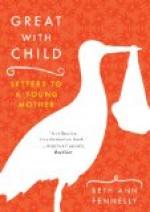It is a very easy thing to have a loose night gown to supply the place of the shirt we have worn during the day; and if nothing else is convenient, a spare shirt will answer. But both a night gown and shirt should never be admitted, especially in warm weather. The garment to supply the place of the shirt during the night, may be of calico in the summer, and of flannel in the winter.
The collar and wristbands of this night dress should be loose; and the whole garment should be large and long. No article of dress should ever press upon our bodies, so as in the least to impede the circulation; and for this reason it is, that writers on physical education have inveighed so much against cravats, straps, garters, &c. This caution, so important to all, is doubly so to young mothers, on whom devolves the management of the tender infant.
When the child has been perspiring freely during the evening, just before he is undressed, or when he has just been subjected to the warm bath, it may be well to use a little care in undressing and exchanging clothes, to prevent taking cold;—though it should ever be remembered, that those children who are managed on a rational system will bear slight exposures with far more safety, than they who have been managed at random—sometimes, indeed, with great tenderness, but at others, wholly neglected.
SEC. 7. Posture of the Body.
In early infancy, children who are not stuffed rather than fed, may occasionally be permitted to sleep on their backs, especially if they incline to do so. But it will be well to encourage them to sleep on one side, as soon as you can without great inconvenience.
The right side, as a general rule, is preferable; because the stomach, which lies towards the left side, is thus left uncompressed, and digestion undisturbed. I would not, however, require a child to lie always on the right side, but would occasionally change his position, lest he should become unable to sleep at all, except in a particular manner.
I have said elsewhere, that the head ought to be a little raised, especially if the child is liable to diseases of the brain. But this remark, rather hastily thrown out, requires explanation.
There is so much blood sent by the heart to the head and upper parts of the system of infants, as to predispose those parts, especially the brain, to disease. In a horizontal position of the body, there is more blood sent to the brain than when the body is erect. This will show the reader, at once, that if the infant is peculiarly exposed to diseases of the brain—and it certainly is so—he ought to remain in a horizontal posture as little as possible, except during sleep; and that even then it is desirable to make his bed in such a manner as to elevate the head and shoulders as much as we can without compressing the lungs, or obstructing the circulation in the neck.
I recommend, therefore, to raise the head of an infant’s bedstead a little higher than the foot; though not so much as to incline him to slide downwards into the bed, for that would be to produce one evil in curing another.




